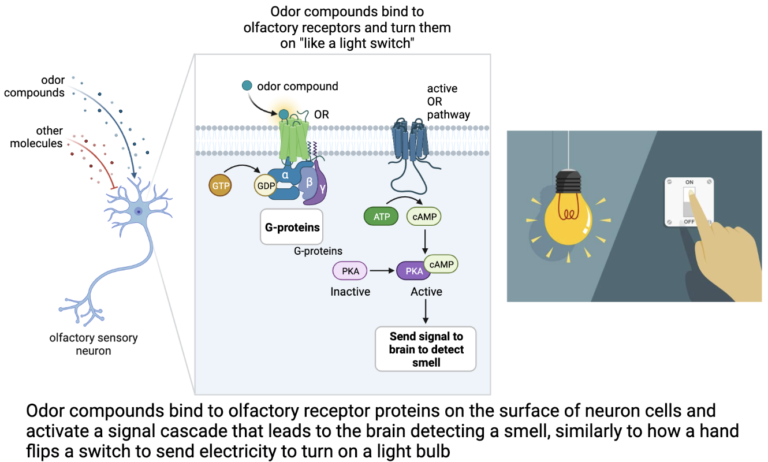Proteins are found in all parts of the body and perform many different types of functions. This includes being essential to the senses, such as sight, taste, and smell. Receptor proteins in the eyes, mouth, and nose respond to external molecules and produce a cascade of signals to the brain that can be interpreted into a sensation. One of the most interesting families of proteins that remains mostly unresolved are the olfactory receptors. Found in the mammalian nose, these receptors are expressed in a specific cell type known as the olfactory sensory neuron (OSN). Each olfactory sensory neuron found in the nose expresses one specific olfactory receptor, and each receptor can recognize a particular range of scented molecules. The path to produce a smell begins when an odorous molecule enters the nose and passes through the nasal epithelium layer, then it interacts with an olfactory receptor in an olfactory sensory neuron, and these neurons produce a signal cascade that results in an electrical signal passing from axon to the next neuron all the way to the olfactory bulb in the brain, where the scent is interpreted.
The word “olfactory” comes from the Latin word meaning “to smell”, and refers to the signal cascade and olfactory bulb in the brain that recognizes compounds and interprets their smell.
Have you ever wondered, then, why a dog can sniff out and detect odors that go unnoticed by humans? A mammal’s sense of smell is an important connection to the environment. It provides cues to danger, such as fire, smoke, and spoiled food, and is linked to processes such as memories and emotions. While humans are capable of discerning multiple scents, a dog’s sense of smell is much more sensitive. The mammalian genome is made up of about 1300 genes for ORs, yet these encode about 350 ORs in humans and over 1000 ORs in canines. For this reason, dogs have been trained to smell multiple types of indicators, including explosives, narcotics, missing persons, human remains, and even disease indicators. Smell detection by canine “sniffer” dogs has become an important resource, and some researchers are even working to develop a mechanism for canine detection of cancer.

The role of proteins in smell detection is revealed in a closer examination of olfactory receptors. These receptors belong to a classification of proteins known as G-protein coupled receptors (GPCRs). This class of GPCRs are found in the membrane of cells, meaning they can access and detect molecules on the outside of the cell, and act as a chemical go-between to transduce signals into the cell. It does this by interacting with internal proteins known as G-proteins, which become activated by the GPCR and go on to turn on other processes within the cell. In the case of olfactory receptors, an odorous molecule will bind to the OR on the cell surface, causing it to move in what is known as a conformational change. This shift releases a G-protein from where it was previously bound to the OR on the interior side of the membrane. Once freed, the G-protein can bind to and modify other proteins in the cell, turning on signaling pathways such as cyclic AMP production and other processes. Think of the OR as a light switch that causes a current of signals to run all the way from that olfactory sensory neuron to the brain, turning on the “light” that is the resulting smell.

Learning more about olfactory receptor proteins is helpful in determining just how the sense of smell can inform and protect us. Since dogs have a uniquely keen sense of smell, they have been trained to detect odor compounds that are beyond the scope of the human receptors. Cancer is one of the most widespread and devastating illnesses across the United States and the world. Due to the stress that cancer induces in the body, the release of volatile organic compounds (VOCs) is associated with various cancer types at different disease stages. Research has shown that dogs are capable of detecting compounds released in human sweat, blood, and urine, leading to interest in training dogs in cancer detection through VOCs. Protein scientists are studying the structure and chemical compound binding sites of canine OR proteins, comparing them to VOCs, and determining whether or not dogs have the ability to sniff out cancer. This will allow for the training of dogs expressing these ORs in the detection of cancer, opening up a new realm of possibility for smell detection and disease prevention.